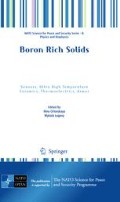Abstract
A model that predicts minimal length and thickness of all ceramic two layer cantilever sensors for chemical and biological detection is proposed. The model allows the estimation of minimal length and thickness where the conditions for the safe cantilever operation are satisfied. Two materials have been chosen for the consideration of the piezoelectric and non-piezoelectric layers in the layered cantilever. A piezoelectric material is lead zirconate titanate and a non-piezoelectric material is boron carbide. Different conditions, such as von Mises criterion and Mohr’s strength theory are considered to find safe stress level in the clamped cross section of the cantilever.
Access this chapter
Tax calculation will be finalised at checkout
Purchases are for personal use only
Preview
Unable to display preview. Download preview PDF.
References
H.-J. Butt, P. Siedle, K. Seifert, T. Seeger, K. Fendler, E. Bamberg, K. Goldie, and A. Engel, Scan Speed Limit in Atomic Force Microscopy, Journal of Microscopy, vol. 169, pp. 75–84, 1993.
P.I. Oden, Gravimetric Sensing of Metallic Deposits Using an End-Loaded Microfabricated Beam Structure, Sensors and Actuators B, vol. 53, pp. 191–196, 1998.
W.Y. Shih, X. Li, H. Gu, W.H. Shih, and I.A. Aksay, Simultaneous Liquid Viscosity and Density Determination with Piezoelectric Unimorph Cantilevers, Journal of Applied Physics, vol. 89, pp. 1497–1505, 2001.
J.W. Yi, W.Y. Shih, R. Mutharasan, and W.-H. Shih, In Situ Cell Detection Using Piezoelectric Lead Zirconate Titanate – Stainless Steel Cantilevers, Journal of Applied Physics, vol. 93, pp. 619–625, 2003.
J.W. Yi, W.Y. Shih, and W.-H. Shih, Effect of Length, Width, and Mode on the Mass Detection Sensitivity of Piezoelectric Unimorph Cantilevers, Journal of Applied Physics, vol. 91, pp. 1680–1686, 2002.
B. Ilic, D. Czaplewsli, H.G. Craighead, P. Neuzil, C. Campagnolo, and C. Batt, Mechanical Resonant Immunospecific Biological Detector, Applied Physics Letters, vol. 77, pp. 450–452, 2000.
T. Thundat, E.A. Wachter, S.L. Sharp, and R.J. Warmack, Detection of Mercury Vapor Using Resonating Microcantilevers, Applied Physics Letters, vol. 66, pp. 1695–1697, 1995.
N. Orlovskaya, M. Lugovy, V. Subbotin, O. Radchenko, J. Adams, M. Chheda, J. Shih, J. Sankar, and S. Yarmolenko, Robust Design and Manufacturing of Ceramic Laminates with Controlled Thermal Residual Stresses for Enhanced Toughness, Journal of Materials Science, vol. 40, pp. 5483–5490, 2005.
G. de With, High Temperature Fracture of Boron Carbide: Experiments and Simple Theoretical Models, Journal of Materials Science, vol. 19, pp. 457–466, 1984.
H.J. Xiang, and Z.F. Shi, Static Analysis for Multi-Layered Piezoelectric Cantilevers, International Journal of Solids and Structures, vol. 45, pp. 113–128, 2008.
S. Timoshenko, Strength of Materials, 3rd ed, Krieger Publishing Company, 1976.
S.C. Hwang, and R.M. McMeeking, A Finite Element Model of Ferroelastic Polycrystals, International Journal of Solids and Structures, vol. 36, pp. 1541–1556, 1999.
A. Nadai, Theory of Flow and Fracture of Solids, Vol. 1, McGraw-Hill, New York, 1950.
S.P. Timoshenko, and J.N. Goodier, Theory of Elasticity, McGraw-Hill, New York, 1970.
Z. Shen, W.Y. Shih, and W.-H. Shih, Self-Exciting, Self-Sensing PbZr0.53Ti0.47O3/SiO2 Piezoelectric Microcantilevers with Femtogram/Hertz Sensitivity, Applied Physics Letters, vol. 89, 023506, 2006.
Author information
Authors and Affiliations
Corresponding author
Editor information
Editors and Affiliations
Rights and permissions
Copyright information
© 2010 Springer Science+Business Media B.V.
About this paper
Cite this paper
Lugovy, M. (2010). All Ceramic Cantilever Sensors with Boron Carbide Layer: Advantages and Dimensional Limitations. In: Orlovskaya, N., Lugovy, M. (eds) Boron Rich Solids. NATO Science for Peace and Security Series B: Physics and Biophysics. Springer, Dordrecht. https://doi.org/10.1007/978-90-481-9818-4_2
Download citation
DOI: https://doi.org/10.1007/978-90-481-9818-4_2
Published:
Publisher Name: Springer, Dordrecht
Print ISBN: 978-90-481-9817-7
Online ISBN: 978-90-481-9818-4
eBook Packages: Physics and AstronomyPhysics and Astronomy (R0)

